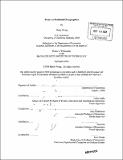| dc.contributor.advisor | Esther Duflo, Amy Finkelstein and Panle Jia. | en_US |
| dc.contributor.author | Wong, Maisy | en_US |
| dc.contributor.other | Massachusetts Institute of Technology. Dept. of Economics. | en_US |
| dc.date.accessioned | 2009-06-30T16:38:51Z | |
| dc.date.available | 2009-06-30T16:38:51Z | |
| dc.date.copyright | 2008 | en_US |
| dc.date.issued | 2008 | en_US |
| dc.identifier.uri | http://hdl.handle.net/1721.1/45924 | |
| dc.description | Thesis (Ph. D.)--Massachusetts Institute of Technology, Dept. of Economics, 2008. | en_US |
| dc.description | Includes bibliographical references. | en_US |
| dc.description.abstract | Many ethnically diverse countries have policies that encourage integration across ethnic groups. This dissertation investigates the impact and welfare implications of a residential desegregation policy in Singapore, the ethnic housing quotas. I employ both reduced form and structural form methods. In Chapter 1, I use regression discontinuity analysis to estimate the impact of the quota on prices, quantity and quality of units sold. Because an individual's decision on where to locate affects ethnic distributions in aggregate, these externalities suggest that any decentralized equilibrium may not be optimal. To find the first best, just using housing prices is not sufficient because prices do not internalize the externalities. We need to know the shapes of household's preferences. In chapter 2, I use a structural demand estimation framework to estimate taste for living with own ethnic group neighbors. Finally, using these preference estimates, I simulate the first best equilibrium and compare it to the existing equilibrium with quotas.I find that all quotas have significant negative impact on the proportion of units sold at the quota cutoffs. Malay-constrained units are 5% cheaper perhaps because the units sold are also of lower quality. The impact on the price and quality of Chinese- and Indian-constrained units are opposite. Chinese-constrained units are 7% more expensive even though the units sold are of significantly worse quality. Indian-constrained units are 2% cheaper even though the units sold are of a higher quality. | en_US |
| dc.description.abstract | (cont.) Using the structural estimation framework in Chapter 2, I find that all groups have strong preferences to live with at least some other members of their ethnic group. However, the shapes of preferences differ significantly across groups. The majority (the Chinese) exhibit preferences that are inverted U-shaped so that after a neighborhood reaches 43% Chinese, they would rather add a new neighbor from the other group. I find similar evidence for the Indians but not for the Malays. My simulations show that the first best has fewer Chinese- and Indian-segregated neighborhoods but more Malay-segregated neighborhoods compared to the existing equilibrium with the quotas. Comparing data from 3 segregated towns before the quota, I find that after 10 years since the introduction of the quota, the decentralized equilibrium had moved the Malay and Indian proportions significantly closer to first best. | en_US |
| dc.description.statementofresponsibility | by Maisy Wong. | en_US |
| dc.format.extent | 90 p. | en_US |
| dc.language.iso | eng | en_US |
| dc.publisher | Massachusetts Institute of Technology | en_US |
| dc.rights | M.I.T. theses are protected by
copyright. They may be viewed from this source for any purpose, but
reproduction or distribution in any format is prohibited without written
permission. See provided URL for inquiries about permission. | en_US |
| dc.rights.uri | http://dspace.mit.edu/handle/1721.1/7582 | en_US |
| dc.subject | Economics. | en_US |
| dc.title | Essays on residential desegregation | en_US |
| dc.type | Thesis | en_US |
| dc.description.degree | Ph.D. | en_US |
| dc.contributor.department | Massachusetts Institute of Technology. Department of Economics | |
| dc.identifier.oclc | 320776205 | en_US |
